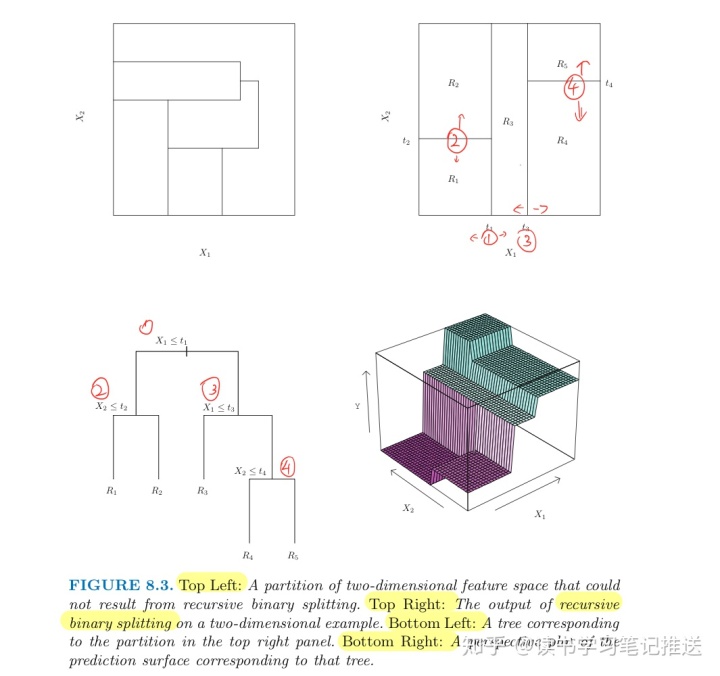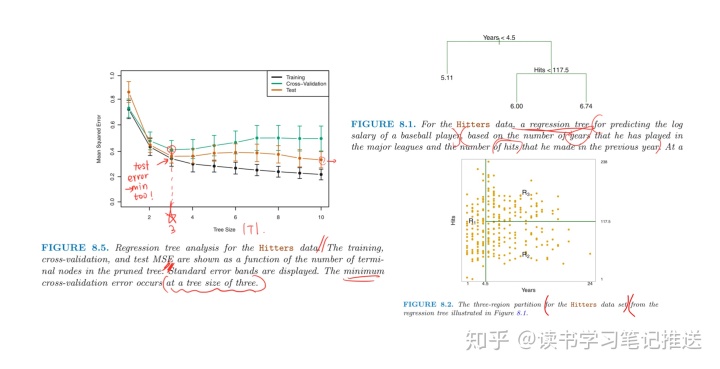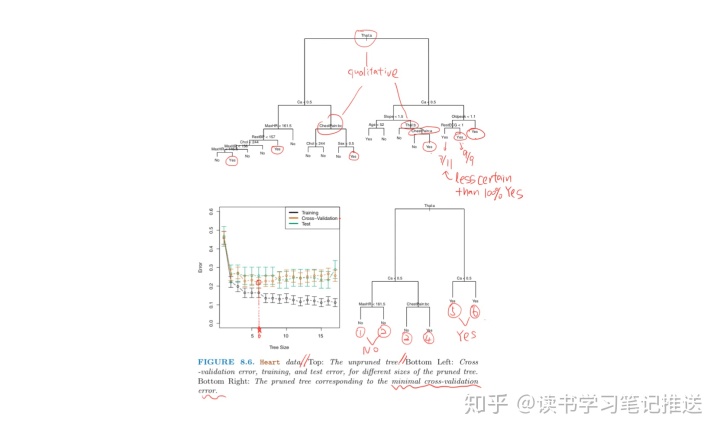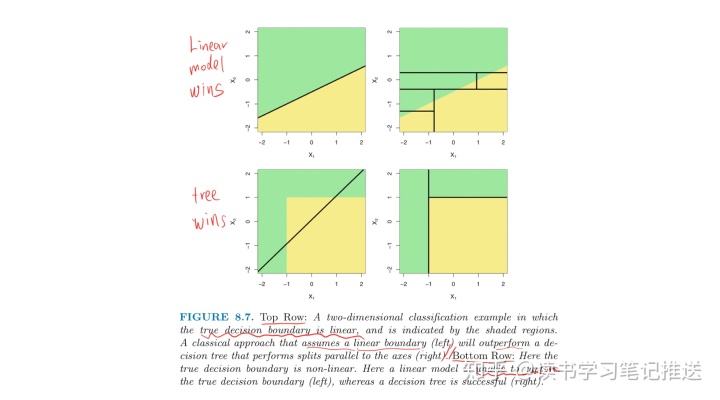ISLR 8.1.1 - 树模型
要点:
0.树模型简介
1.回归树
-- 动机
-- 树分枝
-- 树剪枝
2.分类树
-- 基尼系数
-- 交叉熵
3.树模型vs线性模型
4.树模型优缺点
0. Tree-based methods
Involving stratifying / segmenting the predictor space into a number of simple regions
- Use the mean/mode of the training data in the region as prediction for test data
1. Regression Decision Tree
1.1 Motivation
Making Prediction via Stratification of the Feature Space:
- Divide the predictor space -- that is, the set of possible response
for
-- into
distinct and non-overlapping regions,
- For every test data which will fall into the region
same prediction, which is simply the mean of the response
, we make the
for the training observations in
1.2 Tree Splitting
The goal is to find leaves
- where
mean response for the training observations within the
is the
leaf
「Problem」: it is computationally infeasible to consider every possible partition of the feature space into
「Solution」: Recursive Binary Splitting is a top-down, greedy approach:
- top-down because it begins at the top of the tree (all in one region) and then successively splits the predictor space;
- greedy because the best split is made at each step, rather than looking ahead globally and picking a split will lead to a better tree in some future step(which is impossible)
First, for any feature
to get the best
Next, repeat the process, looking for the best
- until a stopping criterion is reached:
- e.g. no region contains more than 5 observations.
If the number of features
- predict
mean of the train data in the region
in test data using the
to which the test data belongs

1.3 Tree Pruning
「Problem」:Complex Tree will lead overfit (each leaf has one data)
「Solution」: A smaller tree with fewer splits (fewer
「Method 1 - Threshold」
Splitting only as the decrease in the RSS exceeds some (high) threshold
- Problem: too short-sighted since a seemingly worthless split early on may lead to a better split with large reduction in RSS
「Method 2 - Pruning」
Grow a very large tree
- Goal: select a subtree that leads to the lowest test error rate
Rather than CVing every possible subtree, we consider a sequence of trees indexed by non-negative tuning parameter
- Cost Complexity / Weakest Link Pruning
For each value of
-
: number of leaves of the tree
The tuning parameter
-
, just measures the error
- As
penalty for the subtree with many leaves
increases, there is
- so branches get pruned from the tree in a nested and predictable fashion,
- then obtaining the whole sequence of subtrees (as a function of
) is easy
- also can be selected via CV and obtain the subtree corresponding to
- 「Example on Baseball Hitters Data」

Perform 6-fold CV to estimate the CV MSE of the trees as a function of
- CV error is minimum at
based on the best

2. Classification Trees
For a classification tree, we predict the test data belongs to the most commonly occurring class of train data in the region to which it belongs
- RSS cannot be a criterion for classification tree
- need two criterions to evaluate the quality of a particular split
「Gini Index」:
A measure of total variance across the
-
proportion of train data in the
represents the
region that are from the
class
- G small if all
are close 1 or 0
- Node Purity: Smaller if a node contains larger amount of observations from a single class
「Cross-Entropy」:
- Like the Gini Index, the Entropy is smaller if
node is pure
- both are sensitive to node purity
「Heart Disease Example」:

The splits may yield two same predicted value, there are reasons to keep them:
- because it leads to increased node purity
- improves the Gini Index and the Entropy
3. Trees vs Linear Models
If there is a highly non-linear complex relationship between the features and the response, CARTs may outperform classical approaches
- However, there may still be linear relationship

4. Pros & Cons of Trees
「Advantages:」
- Easier to interpret than Linear Regression
- More closely mirror human decision making
- Trees can be displayed graphically
- Easily handle qualitative predictor without the dummy variables
「Limitations」:
- Trees can be very non-robust:
- a small change in the data can cause a large change in the final estimated tree
- Trees do not have the same level of predictive accuracy as other regression and classification methods
- TOGO:By aggregating many decision trees, bagging, random forests and boosting will improve accuracy, at the expense of some loss in interpretation
5. Reference
An Introduction to Statistical Learning, with applications in R (Springer, 2013)




















 435
435











 被折叠的 条评论
为什么被折叠?
被折叠的 条评论
为什么被折叠?








